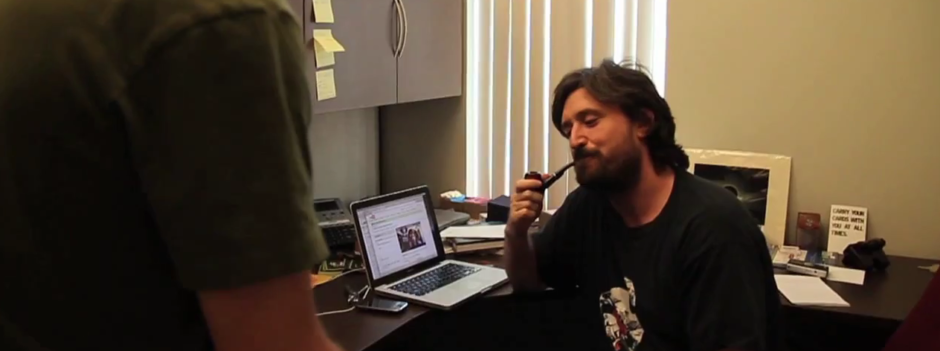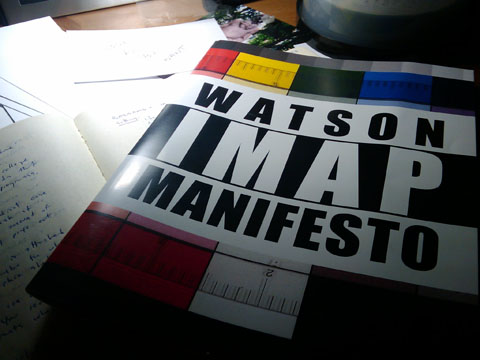[The entirety of this document, including lists of deliverables and a preliminary timeline, can be downloaded in .pdf form here.]
Summary
This course of directed research seeks to identify and implement a range of context- and location-based storytelling techniques by leveraging ubiquitous computing technologies – including mobile communications devices, broadband wi-fi networks, real-time sensor systems and the Internet itself – to create a layered, pervasive and interactive story experience rooted in physical space.
The primary deliverable of this project will be a so-called Alternate Reality Game (ARG) centered on the newly-constructed School of Cinematic Arts (SCA) building at USC. Working in concert with a team of mobile storytelling investigators and technologists headed by professor Scott Fisher, I will coordinate the development of narrative content for a long-arc story experience intended to enrich the physical and virtual environment of the SCA with layers of mystery, playfulness and interactivity.
By implementing a small-scale location-based ARG such as the one proposed herein, I expect to glean a variety of quantitative and qualitative insights into the limitations and possibilities of this nascent narrative form. These insights will feed directly into my primary doctoral inquiry into the question of how an increasingly mobile, ubiquitous and interoperable communications infrastructure can enable new forms of computationally-mediated narrative, both in terms of traditional author-to-audience storytelling and emerging modes of collaborative networked expression and participation. Further, by creating and managing a small team of co-conspirators (see “Approach,” below), and by extending an invitation to participate in the project to the SCA community as a whole (both through the mechanics of the game itself and as a part of the development and pre-production process), I hope to broaden the level of interest in this kind of storytelling by inspiring others to investigate new avenues for the transmedial exploration of character and myth.
Background
Alternate Reality Games (ARGs) are a relatively new form of narrative gameplay – the earliest incarnations of the genre date to the late 1990s and early 2000s – that use the real world and all its myriad communications modalities as the surface upon which to layer story and interaction. As a spatially- and temporally-distributed storytelling form, ARGs deploy narrative across a wide range of expressive media, including physical spaces and artifacts, websites, game worlds, books and graphic novels, music, television and movies, online video, rumors, cell phone content and live performances. For the player-participants of an ARG, apprehending the story and the mechanics of the game is an active investigative or archaeological task, a process of uncovering mysteries and sifting through answers in an effort to find the right questions. As such, playing an ARG is fundamentally distinct from traditional game or story forms in which a “magic circle” of play or spectatorship ceremonially defines the boundaries between the fictional and the real. In an ARG, the line between “in-game” and “out-of-game” is intentionally blurred. Jane McGonigal, a leading researcher in the field, describes this approach as the “this is not a game” (TINAG) aesthetic. When this aesthetic is adhered to with a modicum of discipline, the ARG as a story medium becomes more akin to hoax-making than novel-writing (although, it should be said, an ARG could conceivably deploy a novel as a component of its overall storytelling strategy): like a good hoax, a successful ARG will conceal itself beneath layers of compelling real-world information. Players of ARGs thus often begin playing the game before they even know that a game is afoot. In the apotheosis of this form, by the time players realize that there is an intelligence guiding their investigations into the mysteries that have inexplicably infiltrated their lives, their desire to uncover the truth of the matter becomes irresistible, and players will pursue the mystery to the end of the line, oftentimes sharing their insights and solving game problems collectively via self-organized online interactions.
To date, the peculiar affordances of the ARG have been exploited primarily by media corporations such as Microsoft, Dreamworks and Sony Pictures in order to launch viral marketing campaigns for other products. For example, one of the most successful ARGs in recent memory began with a mysterious bee-keeping website that came to the attention of participants via a brief flash of text at the end of a movie trailer. A great deal of Internet buzz ensued as interested parties began to investigate the website and its provenance, revealing a strange series of what initially appeared to be distress signals from some kind of trapped or kidnapped individual. Increasingly large groups of players began working collectively online to solve the mystery, and as things got weirder and weirder, word-of-mouth drew more and more participants into the world of the story. In the end, this project, known as “ilovebees”, turned out to be a promotional initiative for the launch of Microsoft’s Halo 2.
While the origins and historical applications of the ARG are rooted in viral marketing, more recent iterations employing the TINAG aesthetic have sought to create so-called “self-monetizing” ARGs. For example, 42 Entertainment, the studio that produced ilovebees and several other seminal ARGs, recently partnered with a small press to publish Cathy’s Book, a book for young adults purporting to be the private diary of a missing teenage girl. By framing this publication with an invitation to readers to help locate the missing teenager, the designers were able to simultaneously steer their audience toward multiple story assets exterior to the book itself (e.g. websites mentioned in the book, phone lines accessible via numbers scrawled in the “diary’s” margins, and so on), offset the production costs of writing and producing the project as a whole, and draw new readers to discover (and purchase) the book itself via the creation of an online following. The book sold well, debuting at #7 on the New York Times Best Seller list for Children’s Books, and the online community continues to be active.
In addition to revealing more about the potential uses of the ARG for both viral marketing and self-monetization, a significant goal of the project proposed herein is to explore the capacity of ambient story and game play to create and shape communities of player-participants within the constraints of institutional space. Questions to be addressed include: can ARGs and other kinds of layered or ambient story/game systems help to foster a sense of community and camaraderie in work and study environments? Does the presence of a continuously-unfolding mystery “accelerate serendipity” by bringing like-minded individuals into physical and virtual association in order to solve the mysteries with which they have been confronted? How can an ARG stimulate the production and sharing of media by its participants? More broadly, can highly-mediated approaches to play and narrative that involve the deep and tangled integration of story-telling, story-consuming, and even story-producing, into the fabric of everyday life produce emotional and social effects of similar character to those produced by the novel or the narrative cinema? Addressing these questions through the deployment of a small-scale ARG in the SCA will provide key practical insights into the creation and management of such projects, while also revealing new data regarding the intersection between structured social play and networked computational systems. It is my belief that an inquiry into the nature of this intersection is essential as we enter an age of ubiquitous information technology wherein the respective agencies of authors, crowds and machines promise to collide in productive and unpredictable ways.
Approach
Time is of the essence in the successful development and deployment of an ARG, and this project is no exception. The opening ceremonies for the new SCA Building are scheduled for mid-March, 2009, meaning careful coordination of resources and a strict adherence to a workflow timeline will be essential. To this end, work has already begun in concert with Scott Fisher’s “The Future of the Story” (TFOTS) research group (comprised of Professor Fisher, Will Carter, Marientina Gotsis, Jen Stein and Hidefumi Yasuda) to determine the specific technological, budgetary and personnel requirements and availabilities of the project. By continuing to liaise with this group and its derivatives (such as Will Carter’s “Design and Technologies for Mobile Experiences” class, CTIN 405), I expect to develop a precise set of practical parameters within which the story and game mechanics can operate by mid-January 2009. Once these parameters have been defined, I will begin the process of structuring the story/game experience and creating the necessary narrative content.
To act as a force-multiplier for these efforts, I have assembled a small team (“The Story Group”) of writers, designers and programmers from the ranks of the Graduate Program of the IMD. This team will work under my direction to develop and deploy the creative and technical assets required of the project. Four of these team members will be assigned primary roles and will be paid as interns for their work; an additional cadre of four to six collaborators will work in association with this core group to develop and execute the ARG. Further, as the timeline progresses, “pre-game” elements – small mini-games and story segments deployed in and around the SCA – will act as “rabbit holes,” enticing early participants who themselves will shape the development of the final experience, which will “go live” during the opening ceremonies of the new SCA Building.
UPDATE (15 July 2009): A portion of this project was demonstrated to a small test group in mid-May; observations and comments from the demonstration are forthcoming (as components of a larger paper on Location-Based Ambient Storytelling); their appearance will be noted here.


